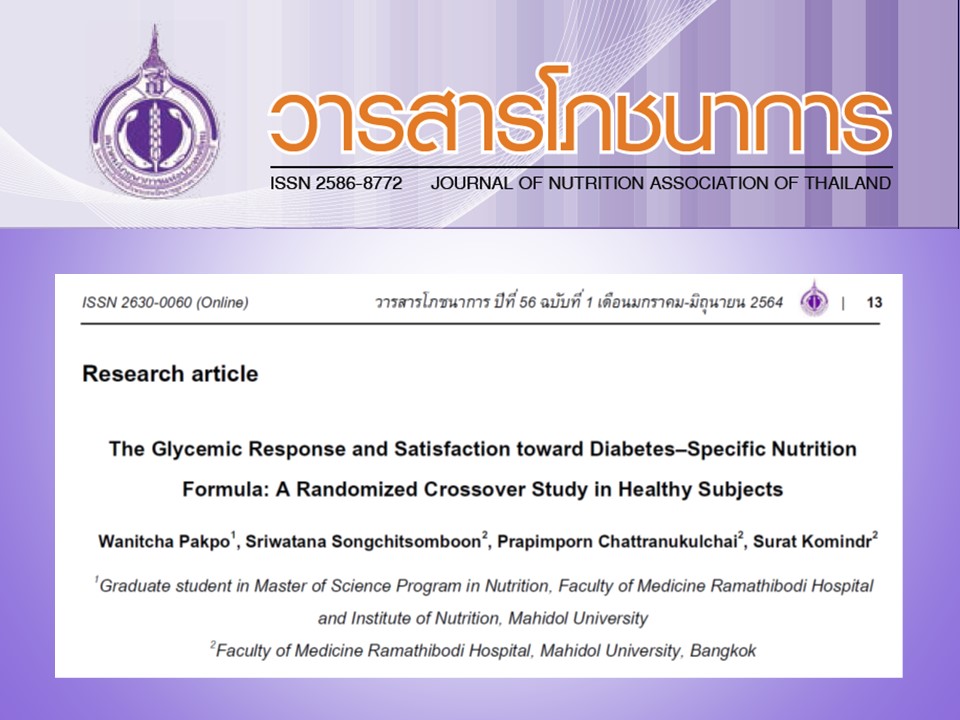The Glycemic Response and Satisfaction toward Diabetes–Specific Nutrition Formula: A Randomized Crossover Study in Healthy Subjects
Keywords:
Glycemic Index, Diabetes-Specific Nutrition Formula, SatisfactionAbstract
The purpose of this research was to use maltodextrin and resistance maltodextrin from tapioca planted in Thailand as the main ingredient for carbohydrates in a diabetes-specific nutrition formula known as diabetic formula 1, and employing a Thai innovation. This study aimed to determine glycemic index (GI) and satisfaction levels of the diabetic formula 1 among 12 healthy consumers using a randomized crossover design. Participants consumed the diabetic formula 1 and a glucose solution as reference at the same amount of 50g. After the consumption period, blood samples were collected at timed intervals over a two-hour period. Satisfaction score was measured using the Visual Analog Scale. Results showed that the postprandial plasma glucose (PPG) of diabetic formula 1 increased from fasting levels but was significantly lower than for the glucose solution starting from 15 through 90 min. The incremental area under the curve (IAUC) of blood glucose was significantly lower for diabetic formula 1 than for the glucose solution. Our clinical results showed that diabetic formula 1 had a low GI at 16.5 ± 2.4. For satisfaction, although every aspect of the visual analogue scale had a passing grade (>50), subjects rated ‘poor’ for the diabetic formula 1 in terms of taste, aftertaste and palatability. Therefore, the diabetic formula 1 needs further development to raise consumer acceptance.
References
FAO/WHO. Carbohydrates in human nutrition. Chapter 4 - The role of the glycemic index in food choice. FAO Food and Nutrition Paper - 66. 1998.
American Diabetes Association. Prevention or delay of type 2 diabetes: standards of medical care in diabetes. Diabetes Care 2018; 41:51-4.
Thomas D, Elliott EJ. Low glycaemic index, or low glycaemic load, diets for diabetes mellitus. Cochrane Database Syst Rev 2009; 2009(1):CD006296.
Wheeler ML, Dunbar SA, Jaacks LM, Karmally W, Mayer-Davis EJ, Wylie-Rosett J, et al. Macronutrients, food groups, and eating patterns in the management of diabetes: a systematic review of the literature, 2010. Diabetes Care. 2012; 35(2):434-45.
Eleazu CO. The concept of low glycemic index and glycemic load foods as panacea for type 2 diabetes mellitus; prospects, challenges and solutions. Afr J Health Sci 2016; 16(2):468-79.
Komindr S, Ingsriswang S, Lerdvuthisopon N, Boontawee A. Effect of long-term intake of Asian food with different glycemic indices on diabetic control and protein conservation in type 2 diabetic patients. J Med Assoc Thai 2001; 84(1):85-97.
Group UPDS. Effect of intensive blood-glucose control with metformin on complications in overweight patients with type 2 diabetes (UKPDS 34). Lancet 1998; 352(9131):854-65.
McMillan-Price J, Brand-Miller J. Low-glycaemic index diets and body weight regulation. Int J Obes 2006; 30:S40.
Nathan DM. Diabetes Control and Complications Trial/Epidemiology of Diabetes Interventions and Complications (DCCT/EDIC) Study Research Group: Intensive diabetes treatment and cardiovascular disease in patients with type 1 diabetes. N Engl J Med 2005; 353:2643-53.
Hise ME, Fuhrman MP. The effect of diabetes-specific enteral formulae on clinical and glycemic indicators. Prac Gastroenterology. 2009; 74:20-36.
Elia M, Ceriello A, Laube H, Sinclair AJ, Engfer M, Stratton RJ. Enteral nutritional support and use of diabetes-specific formulas for patients with diabetes: a systematic review and meta-analysis. Diabetes Care 2005; 28(9):2267-79.
Raben A. Should obese patients be counselled to follow a low‐glycaemic index diet? No. Obes Rev 2002; 3(4):245-56.
Flint A, Raben A, Blundell J, Astrup A. Reproducibility, power and validity of visual analogue scales in assessment of appetite sensations in single test meal studies. Int J Obes 2000; 24(1):38.
Shmueli A. The visual analog rating scale of health-related quality of life: an examination of end-digit preferences. Health Qual Life Outcome 2005; 3:71.
Brennan C, Tudorica C. The role of complex carbohydrates and non-starch polysaccharides in the regulation of postprandial glucose and insulin responses in cereal foods. J Nutraceuticals, Functional & Medical Foods 2002; 4:49-55.
Gourineni V, Stewart ML, Skorge R, Wolever T. Glycemic index of slowly digestible carbohydrate alone and in powdered drink-mix. Nutrients 2019; 11(6):1228.
Ojo O, Ojo OO, Adebowale F, Wang XH. The effect of dietary glycaemic index on glycaemia in patients with type 2 diabetes: a systematic review and meta-analysis of randomized controlled trials. Nutrients 2018; 10(3);373.
Institute of Food Technologists (IFT). Guidelines for the preparation and review of papers reporting sensory evaluation data. Sensory Evaluation Division, Institute of Food Technologists. 2019.

Downloads
Published
How to Cite
Issue
Section
License
Upon acceptance of an article, copyright is belonging to the Nutrition Association of Thailand.


